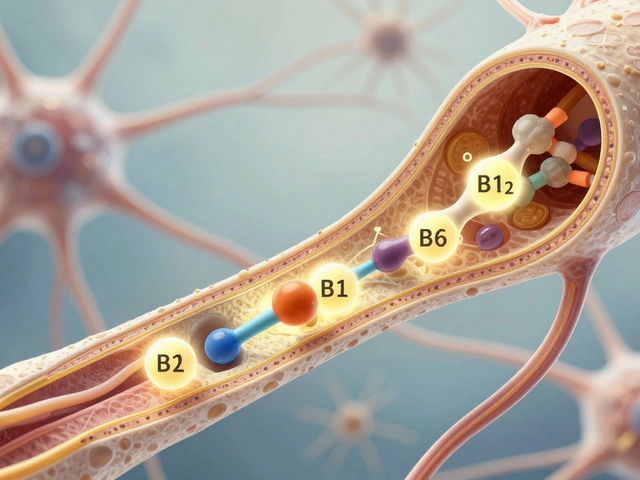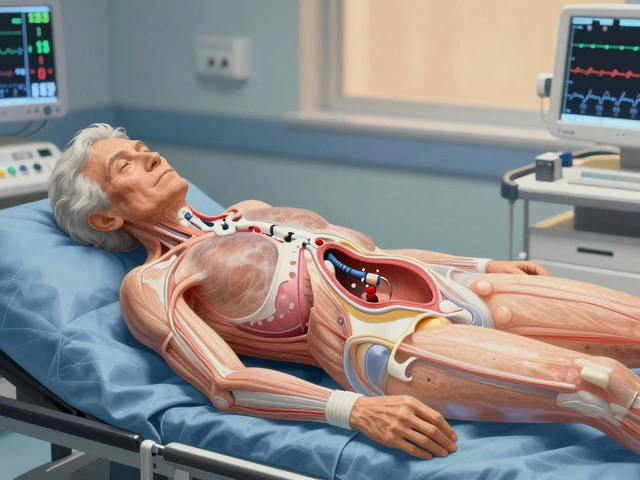You know, it's not every day you hear good news about cancer survival rates. But here's the thing: thyroid cancer actually boasts a 95% survival rate. That's a pretty big deal, right? So what exactly makes thyroid cancer different from the other types? It all boils down to a mix of factors, from the cancer's nature to advancements in treatment.
Thyroid cancer often decides to grow slowly, which is a blessing because doctors can catch it before things get nasty. It doesn't spread to other parts of the body as easily as some other cancers. Plus, with the treatment options available today, people have a really good shot at beating it.
The key here is early detection. Regular screening can play a huge role in nabbing this cancer before it starts causing problems. And let's not forget, technology and medicine have come leaps and bounds, ensuring better outcomes for those diagnosed with thyroid cancer.
- Understanding Thyroid Cancer
- Survival Rates: What Makes Them So High?
- The Role of Early Detection
- Treatment Options and Innovations
- Risk Factors You Should Know
- Maintaining A Healthy Lifestyle Post-Treatment
Understanding Thyroid Cancer
First off, what's the deal with the thyroid anyway? It's that little butterfly-shaped gland sitting in your neck, doing a big job of controlling how your body uses energy. Sounds crucial, right? Well, it is! And when things go awry with this gland, thyroid cancer can pop up.
So, here’s the thing about thyroid cancer: it typically falls into a few different types, with papillary and follicular being the most common. Papillary thyroid cancer makes up about 80% of all cases, and it's generally not aggressive. It's usually in no rush to spread and can often take its sweet time, which is good news for treatment.
Now, you might wonder how folks even find out they have thyroid cancer. Often, it's found during a routine check-up or noticed as a lump in the neck. Doctors might then use ultrasounds or blood tests to get a clearer picture. Fast detection is a huge plus in boosting those survival rates.
Let's talk numbers for a bit. The prognosis for thyroid cancer is generally quite favorable, which is a relief. In fact, the overall 5-year survival rate sits at about 95%. Here's a quick rundown for perspective:
| Type | 5-Year Survival Rate |
|---|---|
| Papillary | Nearly 100% |
| Follicular | Around 98% |
These stats are quite encouraging, aren't they?
In essence, knowing more about this cancer means you're better prepared. Whether it's understanding the types or knowing how it's caught, being informed empowers you to take action if needed.
Survival Rates: What Makes Them So High?
Alright, let’s get into why thyroid cancer boasts such impressive survival rates. Firstly, the nature of the cancer itself plays a huge role. Most types of thyroid cancer, particularly papillary and follicular, are less aggressive compared to other cancers. They grow slowly, giving doctors ample time to detect and treat them effectively.
Another big factor? Early detection. Thyroid cancer can often be picked up before it causes any pesky symptoms, especially when people go for routine check-ups. Regular ultrasounds and blood tests for thyroid function mean this cancer doesn’t usually get away with sneaking up on us.
Treatments are super effective too. Surgery is the main go-to method, often followed by radioactive iodine treatment. These not only target the cancer but are tailored to limit harm to healthy cells, making the recovery process smoother.
On top of this, advancements in medical research have dramatically upped the game for treatment options. New therapies are being tested all the time, providing more options for patients. Cancer treatment has seen huge leaps forward in the last few decades thanks to continuous research.
Here’s a bit of data to give you an idea:
| Type of Thyroid Cancer | 5-Year Survival Rate |
|---|---|
| Papillary | Almost 100% |
| Follicular | Close to 95% |
Still, it’s not all smooth sailing. Some rare types, like anaplastic thyroid cancer, are more challenging to treat. But the good news is, they only make up a small fraction of cases.
So, while hearing 'cancer' can be scary, the stats for thyroid cancer should offer a serious sigh of relief. It's that combo of early detection, treatment effectiveness, and the cancer's own behavior that's got our backs.
The Role of Early Detection
Catching thyroid cancer early is like spotting a minor leak before it becomes a flood. The sooner it's found, the better the odds of treating it successfully, leading to the amazing 95% survival rate that those with thyroid cancer enjoy. It's almost like having a head start in a race.
So how does one get a jump on this? Regular check-ups can’t be stressed enough. Doctors often run blood tests or even ultrasound exams if they suspect any funny business with the thyroid, especially if there are symptoms like a persistent cough, hoarseness, or a noticeable change in voice.
What's super helpful is the use of imaging technologies, which are getting better by the day. These can spot tiny nodules that you wouldn't even feel with your hand. And as intimidating as it might sound, a biopsy is often the go-to move for many doctors. They just take a small sample of thyroid tissue to check it out under a microscope. No biggie, right?
Furthermore, being aware of the risk factors—like family history or exposure to radiation—can help in deciding when screenings should happen more frequently. If Uncle Raj had thyroid issues, it might be a good idea to stay on top of any thyroid-related changes.
Here’s a little tip checklist to keep in mind:
- Don’t skip those routine doctor visits.
- Mention any unusual symptoms, no matter how small they seem.
- If there's a family history of thyroid problems, share it with your doc.
- Keep an eye out for neck swelling or lumps.
And here’s a glimpse of how early detection is stacking up:
| Stage | 5-year Survival Rate |
|---|---|
| Localized | Almost 100% |
| Regional | 98% |
| Distant | 54% |
These stats show that with early detection, the chance of outsmarting thyroid cancer is pretty darn high. Remember, awareness and proactive action can really make a world of difference.

Treatment Options and Innovations
When it comes to dealing with thyroid cancer, you're not in the fight alone, thanks to some solid treatment options that are available today. Surgery is often the go-to move for many patients. The idea is to remove part or all of the thyroid gland, which can effectively stop the cancer from spreading. It's like cutting off the problem at the source.
Radioactive iodine therapy is another power player in treating thyroid cancer. You heard it right—using radiation. But don't freak out! It's a targeted approach, meaning it zaps away cancerous cells with minimal impact on the rest of your body. It’s often used after surgery to ensure nothing sneaky got left behind.
Now, let's talk about hormone therapy. Since the thyroid produces hormones all day long, if it's removed or partly removed, you'll need medication to replace those hormones. This keeps your body's hormones balanced and helps prevent any leftover cancer cells from growing.
And here’s the cool part—in recent years, targeted therapies and immunotherapies have stepped onto the scene, offering hope especially for those rare cases when things are a bit trickier. These advanced treatments focus on the cancer cells directly and leave healthy cells alone. Pretty smart, right?
Some key stats to highlight the impact of these treatments include:
| Treatment Method | Success Rate |
|---|---|
| Surgery | Over 90% |
| Radioactive Iodine | Highly effective post-surgery |
| Targeted Therapy | 85% in complex cases |
The landscape for thyroid cancer treatment is continuously evolving, with new research paving the way for even better outcomes. Keep an eye on these developments as they promise to make fighting thyroid cancer even more successful.
Risk Factors You Should Know
So, let's chat about the stuff that might increase the risk of getting thyroid cancer. It's crucial to be aware because knowing these can help you spot early warning signs and maybe even take steps to avoid them.
First off, if you're a woman, you're more likely to develop thyroid cancer than men. Why? Nobody's exactly sure, but hormones might play a role. Age is another factor—you’ll see more cases in people over 30, and the risk bumps up even more after 60.
Ever heard of a family legacy with health issues? It applies here too. If someone in your family had thyroid cancer or other thyroid problems, you might want to be extra vigilant. A family history can definitely be a red flag.
There’s also the radiation exposure deal. If you were exposed to high radiation levels as a child, maybe from radiation therapy for other conditions, it can put you in the risk zone for this cancer.
"Exposure to radiation, particularly in childhood, is a significant risk factor. It's all about the doses and the age—it’s something to keep on your radar," says Dr. Anita Desai, a leading oncologist.
Another curious player in this mix is diet. Low iodine in your diet might not create a buffet for thyroid health. Iodine is a must for proper thyroid function, but hey, don't panic—it's usually added to table salt.
- Gender: Women get it more often than men.
- Age: Common in folks over 30, but more so after 60.
- Family History: Got relatives who’ve had thyroid issues? Stay cautious.
- Radiation Exposure: Childhood exposure raises risk.
- Diet: Low iodine levels can be a factor.
If these points hit home for you, it’s about staying on top of health check-ups. Spotting issues early is half the battle when it comes to cancer treatment.
Maintaining A Healthy Lifestyle Post-Treatment
Making it through thyroid cancer treatment is a huge win. But the journey doesn’t stop there. It’s crucial to keep up a healthy lifestyle to ensure long-term well-being and reduce the chances of any recurrence. So, what can you do to take care of yourself now?
First off, focus on eating well. A balanced diet can do wonders. Load up on fruits, veggies, lean proteins, and whole grains. These foods not only boost your immune system but also help with recovery. Avoid processed foods and cut back on sugar to keep things on the healthier side.
- Regular Exercise: Just a bit of a sweat session can make a big difference. Aim for at least 150 minutes of moderate activity a week. That could be brisk walking, cycling, or swimming. It doesn't just keep your body fit; it boosts your mood too.
- Stay Hydrated: Water is often the unsung hero of recovery. It helps flush out toxins and keeps you energized. Make it a habit to drink plenty of water throughout the day.
- Sufficient Sleep: Your body needs rest to heal and recover. Try to stick to a regular sleep schedule and ensure you get 7 to 9 hours of quality sleep each night.
- Regular Check-ups: Keep in touch with your healthcare team. Regular follow-ups and screenings are key to catching any potential issues early.
Don’t forget the importance of mental health. Dealing with cancer can be tough on the mind too. Consider joining a support group or talking to a mental health professional if you're feeling stressed or anxious.
Here's a quick look at some essentials to keep in mind:
| Aspect | Goal |
|---|---|
| Exercise | 150 mins/week |
| Water Intake | 8 glasses/day |
| Sleep | 7-9 hours/night |
| Check-Ups | Follow scheduled visits |
Remember, it’s about making small, consistent changes. With the right steps, you can live a healthy and fulfilling life after thyroid cancer treatment.










